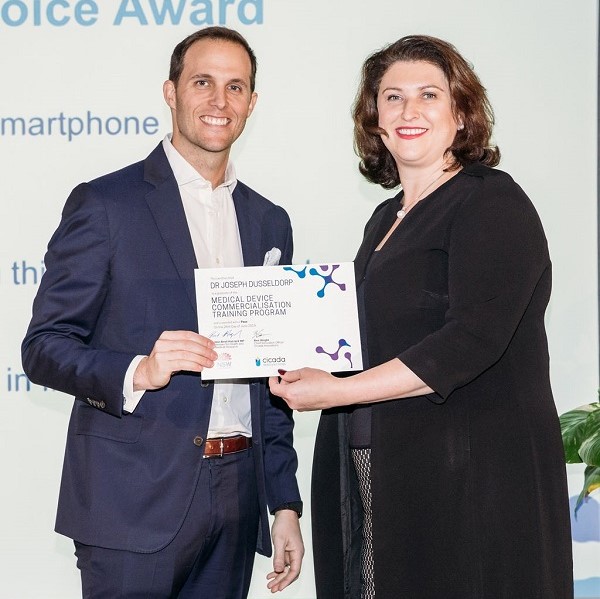Boosting the commercialisation prospects of a potentially life-changing device for kids with cerebral palsy
What a difference a year can make. Sydney-based reconstructive plastic surgeon Dr Joe Dusseldorp expected to develop new skills and techniques when working on a new approach to a complex medical problem during his fellowship at Harvard University. But even he was surprised by how much the experience fired his imagination and reframed his working life.
He came home determined to find ways to push emerging technologies into new frontiers. And the NSW Health Medical Device Commercialisation Training Program he completed in 2019 gave him the skillset to ramp up his efforts: to speak the language of commercialisation, to bring together complex teams, plan clinical trials and make him grant-ready.
Dusseldorp, part of a 5-generation family of doctors, was already drawn to cutting-edge medical technologies before spending 2 years at innovative centres in the US. At Harvard, he joined a team developing a neuro-prosthetic device to treat facial palsy — a condition affecting facial nerves, rendering people unable to smile or close an eye properly.

From the beating of the heart to the flash of a smile, the human body is driven by electrical impulses. A remedy for facial palsy has been to transplant nerves and muscles, involving complex surgery with a long recovery. The Harvard team, driven by a desire for more reliable outcomes, explored whether an implanted device could stimulate the nerves for a better result. In a similar way, Dusseldorp explains, the Cochlear implant restores hearing using electrical signals to directly stimulate the auditory nerve, and the permanent pacemaker helps a failing heart to beat in the proper manner.
“My time at Harvard opened my eyes to the field of medical device development,” he says. “There was a disruptive mindset all around me; everyone was looking to make quantum leaps rather than step-wise contributions and that rubbed off on me. When I came back, I was looking at how do I develop a medical device to make a massive difference to people living with disabilities.”
Dusseldorp started by exploring existing technology in the field of nerve stimulation, and considering whose lives it could change. As the plastics registrar working in a hand surgery unit, he had previously worked with patients with cerebral palsy, cutting and lengthening tendons to relieve spasms. Sadly, however, this technique could not restore function. Could electrical stimulation, he wondered, relieve spasms in people and help them to use their hands better — especially children with cerebral palsy?
He set up the Sydney Neurobionics Collaboration (SyNC) to connect a range of experts and share innovative ideas: not just engineers and scientists, but also patients and carers. One of these contacts was John Parker, founder and Chief Scientific Officer of Saluda Medical, itself a past recipient of NSW Health Medical Devices Fund support. The company has been on the long journey to commercialisation with a device that uses electrical nerve stimulation to treat chronic neuropathic pain.
“I didn’t believe there was technology like what John Parker had developed,” says Dusseldorp. “That was just good fortune that we happened to be in the right place at the right time — their capability and my level of interest in cerebral palsy was one of those serendipitous moments.”
Another factor that Dusseldorp credits as critical to making the connection was taking his place in the NSW Health Medical Device Commercialisation Training Program, a course that quickly expanded his horizons.
“It gave me the opportunity to really delve into issues that I had never grappled with in my prior studies like intellectual property, regulatory hurdles, reimbursement pathways and designing clinical trials. Much of what is required to clinically translate a technological solution was covered in that course.”
Dusseldorp says the training gave him an entirely new vocabulary essential for developing a commercial device and, importantly, identifying what he didn’t know.
“Part of my medical training was coming to terms with that anyway,” he says. “The further you delve into becoming a specialist in a medical field, the more you realise how little you actually know. To me, the idea of becoming an expert is really a quest for more knowledge — to seek new solutions for difficult problems. You can’t ever be finished, which is great. It’s what makes it exciting.”
Dusseldorp and Parker are planning to use a device known as a closed loop spinal cord stimulator in a clinical trial to assist children living with cerebral palsy. In this trial, two wires are threaded up either side of the spinal column in the epidural space and then connected to a matchbox-sized device they hope will ease the spasms associated with cerebral palsy. Dusseldorp explains that “the device delivers the correct signal from the brain telling the spinal cord to just chill out, calming down the reflexes that are overactive in cerebral palsy”. Spasms cause a lot of difficulty for children living with cerebral palsy and they currently receive a variety of different treatments for this issue, including injections of botulinum toxin and orthopaedic surgeries.
An expert community has been assembled to plan a clinical trial with the first trial surgery slated for later this year. The technology, he says, is relatively straightforward but to take advantage of the neuroplasticity of children, the challenge is to shrink the components to make them suitable for their smaller bodies.
“There’s something inherent in what I do as a plastic surgeon that involves some degree of imagination and creativity. The freedom to think about new treatments and new ways of doing things is gratifying, but the really joyful part of my work is to spend time with people, in particular children and their parents, finding ways to help them live full and rewarding lives. That’s what drives me.”
By Michelle Schlechta
Updated 4 years ago